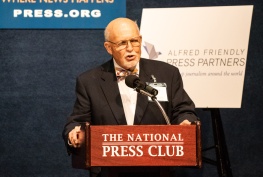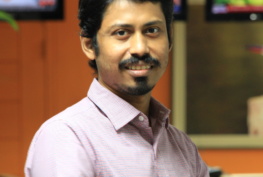
The Kyiv Independent expected harsh criticism for publishing a negative story about foreign soldiers defending Ukraine from Russia’s onslaught.
“This story is very complicated, and not something the government probably wants to hear and see,” Kyiv Independent staffer Olena Goncharova Lafoy said during an Alfred Friendly webinar Dec. 2.
The Independent, which launched in January, went ahead and published the two-part investigation in August and late November to shed light on corruption within the International Legion.
“We get some comments that we do not respect our military, that we are enemy spies,” said Lafoy, one of three former Alfred Friendly Fellows who helped start the Kyiv Independent, now the largest English language outlet in Ukraine. “It was quite hurtful.”
“We feel like it is our duty to make sure people who are supporting Ukraine … are well aware that those things unfortunately exist, and we are not trying to hide them under the rug,” she said. “In Ukraine, we are lucky that independent media can indeed survive and work freely despite the war.”
Ahmad Noorani, who developed the digital platform FactFocus.com during his fellowship, said he appreciated Lafoy’s comments because he’s also harshly criticized for exposing corruption involving Pakistan’s all-powerful military.
Alfred Friendly organized a conversation with Noorani, Lafoy and other former Fellows so they could share key lessons about developing news platforms. (View videos linked below this story) The other participants were:
- Deepak Adhikari, who this year launcheds NepalCheck,
- Saurav Rahman, who is about to launch a news “laboratory” in Bangladesh that will do fact-checking and research disinformation and misinformation, with funding from the Organized Crime and Corruption Reporting Project;
- Juan Luis García, who co-founded an anti-corruption reporting platform in Mexico in 2021 that lasted a year, funded in part by an investigative reporting grant. This year he started a network of environmental journalists focused on marine issues in Mexico. The Journalism Network of the Sea (Red de Periodismo del Mar) involves a team of 35 journalists. He “fell in love with nonprofits” during his fellowship in 2018, when he worked at the Texas Tribune, a highly successful member-supported, digital-first, media organization;
- Veengas Yasmeen, who during her fellowship in 2017 developed the digital news outlet The Rise News to cover issues such as equal rights for women and religious minorities. It later became Pakistan’s first registered news media nonprofit organization.
More than half of this year’s Fellows this year worked at nonprofit news organizations, a growth area amid the overall decline of news outlets worldwide. The number of newsrooms in the Institute for Nonprofit News Network has doubled over the past four years and now exceeds 400 independent news organizations.
Journalists around the world like these alumni must now be entrepreneurs as well as reporters, and their survival kit must include knowledge of accounting, funding, management and other business skills.
The fellowship program in 2015 started providing this kind of training, and graduates have launched an array of small, independent digital news outlets that are finding large audiences amid the overall decline of traditional media outlets.
Developing a robust social media presence is essential for nonprofits and small news media, and Noorani and Lafoy shared examples of their success.
The Kyiv Independent now has more than 2 million followers on Twitter, Lafoy said, and Illia Ponomarenko, a 2020 Fellow who covers the war at the frontlines, has about 1.2 million followers on his personal Twitter account. (Here’s a link to Ponomarenko’s story)
Noorani turned to social media after Pakistan’s government blocked his website to people inside Pakistan 15 minutes after he published an exposé in late November. He used leaked tax documents to show that the family of the country’s most powerful military chief accumulated nearly $56 million while in office. (Here’s a link to our story about Noorani’s exposé)
“In a country like Pakistan, if people will not take an interest in any story and then comes the news that a story has been blocked, the attention of the whole of the nation will go to that thing,” Noorani said.
His first tweet about the blockage had 2 million engagements, and after a public outcry the government unblocked his website.
Lafoy, a development manager for the Kyiv Independent, said they’ve also had success with reader-based projects and the membership platform Patreon.
“We can hear from our readers and from our supporters what they want to know, what they want us to cover, and they brought us a lot of great ideas,” she said. “We really feel that this way we engage with our audience in a very high-quality way.”
García said he and colleagues at Aguamala ended their project because of “burnout.” The website wasn’t generating enough money for them to leave their full-time jobs, so they moonlighted to develop their platform and publish investigative stories that focused on corruption in government and in the armed forces.
“One of the key things to success in this kind of business is having multiple financing sources,” García said.
Adhikari agreed, and said that for most journalists running nonprofits, “fundraising is not your cup of tea.”
“You also become an employer,” he said. “You need to raise funds, and you need to pay your colleagues, your staff, and that really changes things. You know the the mindset — I may be good at editing, but I am very bad at managing people. I’m very bad at raising money, basically begging, so you learn.”
During the training at the Missouri School of Journalism, Fellows now get extensive advice from Alfred Friendly President Randy Smith, who founded Missouri Business Alert and is the university’s endowed chair of business journalism.
“One of the things that I saw that is true amongst everyone is collaboration,” Smith said at the end of the Dec. 2 webinar.
“In the past, we competed with others. In this new world, we have to collaborate with each other, and through collaboration we can also perhaps find new ways to not only provide content, but also to look for new sources of revenue.”





